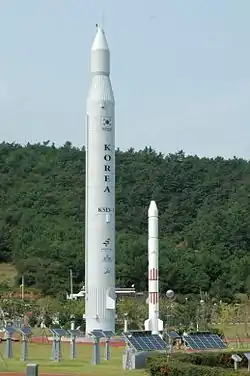Naro Space Center
Naro Space Center is a South Korean spaceport in South Jeolla's Goheung County, operated by the state-run Korea Aerospace Research Institute.
 KSLV-II TLV stands vertical on the Naro Space Center LC-1. | |
| Agency overview | |
|---|---|
| Formed | June 11, 2009 |
| Type | Governmental |
| Jurisdiction | South Korean government |
| Headquarters | Naro Space Center : Outer Naro Island, Goheung County, Jeollanam-do 34°25′55″N 127°32′06″E |
| Employees | 829 (2011) |
| Annual budget | ₩298 billion ≈ US$255 million (2011) |
| Agency executives |
|
| Parent department | Ministry of Science and ICT |
| Parent agency | KARI |
| Website | Naro Space Center (KARI, KSLV-1) Naro Space Center (KARI) |
| Naro Space Center | |
| Hangul | 나로우주센터 |
|---|---|
| Hanja | 羅老宇宙센터 |
| Revised Romanization | Naro Uju Senteo |
| McCune–Reischauer | Naro Uju Sentŏ |
The spaceport is located about 485 km (300 mi) south of Seoul.[1] It includes two launch pads, a control tower, rocket assembly and test facilities, facilities for satellite control testing and assembly, a media center, an electric power station, a space experience hall and a landing field.[2][3] It supported 4 launches, and will also support the KSLV-II launch in 2021, and SSLV launches in 2025.
History
Naro-1
The first launch, initially planned for 19 August 2009, was performed on 25 August 2009 using a Russo-South Korean Naro-1 rocket, but failed to reach the desired orbit. Another rocket launch from Naro was planned for May 2010, but delays pushed the launch to June. On June 10, 2010, this second attempt also ended in failure when the rocket lost communications 137 seconds after launch. The South Korean science minister Ahn Byung-man later told reporters that the rocket was believed to have exploded. A third attempt was made on January 30, 2013 and finally succeeded in putting a satellite into orbit.
KSLV-II TLV
The TLV (Test Launch Vehicle) was the second vehicle to use the Naro Space Center. It was launched on a suborbital mission on 28 November 2018, having a mission objective of qualifying the KRE-075 engine which will power the KSLV-II. The launch was a success. The single-stage TLV rocket reached an altitude of 209 kilometers before splashing down into sea; the flight was 10 minutes long.
Facilities
LC-1 (LB-1)
LC-1, also called as LB-1 for the pad itself, is the first pad constructed in the Naro Space Center. It supported 3 Naro-1 launches and the KSLV-II TLV launch. It will also support the SSLV (Small Satellite Launch Vehicle) launch from 2025.
LC-2 (LB-2)
LC-2, also called as LB-2 for the pad itself, is the second pad in the Naro Space Center. It will support the KSLV-II launch from 2021. Different from LC-1, which doesn't have an umbilical tower, LC-2 has a tower to support the KSLV-II. The site is now on construction.
References
- Software glitch halts rocket launch - Yonhap News Agency
- South Korea Begins Construction Of New Space Center – Korean Information Service, SpaceDaily, August 12, 2003
- "Korea to enter space race in 2008", http://www.korea.net/News/News/NewsView.asp?serial_no=20080102014&part=107%7C, Ro Ji-woong Korea.net Staff Writer, 03 January, 2008, accessed October 28, 2008